
A skid row, also called skid road, is an impoverished area, typically urban, in English-speaking North America whose inhabitants are mostly poor people "on the skids". This specifically refers to people who are poor or homeless, considered disreputable, downtrodden or forgotten by society. A skid row may be anything from an impoverished urban district to a red-light district to a gathering area for people experiencing homelessness or drug addiction. In general, skid row areas are inhabited or frequented by impoverished individuals and also people who are addicted to drugs. Urban areas considered skid rows are marked by high vagrancy, dilapidated buildings, and drug dens, as well as other features of urban blight. Used figuratively, the phrase may indicate the state of a poor person's life.

Downtown Los Angeles (DTLA) is the central business district of the city of Los Angeles. It is part of the Central Los Angeles region and covers a 5.84 sq mi (15.1 km2) area. As of 2020, it contains over 500,000 jobs and has a population of roughly 85,000 residents, with an estimated daytime population of over 200,000 people prior to the COVID-19 pandemic.

Chinatown is a neighborhood in Downtown Los Angeles, California, that became a commercial center for Chinese and other Asian businesses in Central Los Angeles in 1938. The area includes restaurants, shops, and art galleries, but also has a residential neighborhood with a low-income, aging population of about 7,800 residents.
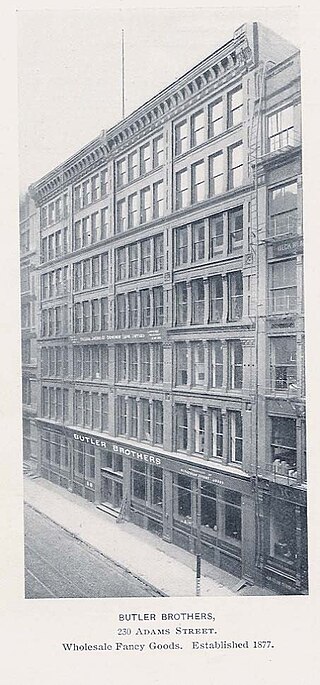
Butler Brothers was a retailer and wholesale supplier based in Chicago. It was founded in 1877 as a mail-order company by Charles Hamblet Butler, George H. Butler and Edward Burgess Butler.
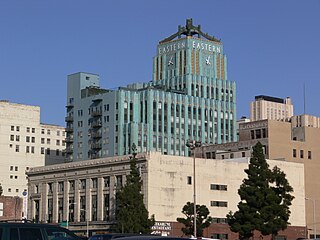
The Historic Core is a district within Downtown Los Angeles that includes the world's largest concentration of movie palaces, former large department stores, and office towers, all built chiefly between 1907 and 1931. Within it lie the Broadway Theater District and the Spring Street historic financial district, and in its west it overlaps with the Jewelry District and in its east with Skid Row.
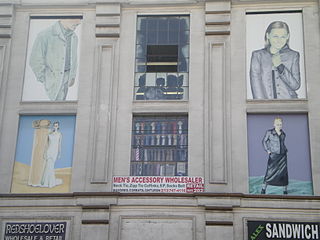
The Los Angeles Fashion District, previously known as the Garment District, is a business improvement district (BID) in, and often cited as a sub-neighborhood of, Downtown Los Angeles. The neighborhood caters to wholesale selling and has more than 4,000 overwhelmingly independently owned and operated retail and wholesale businesses selling apparel, footwear, accessories, and fabrics.

Gallery Row is a neighborhood in downtown Los Angeles, designated by the city council in 2003 to promote the concentration of art galleries along Main and Spring Streets.
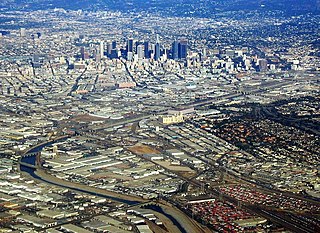
The Wholesale District or Warehouse District in Downtown Los Angeles, California, has no exact boundaries, but at present it lies along the BNSF and Union Pacific Railroad lines, which run parallel with Alameda Street and the Los Angeles River. Except for some ancillary commercial uses, its cityscape is mostly occupied by warehouses and refrigerated storage facilities. This area is known as Central City North in the Los Angeles city zoning map.
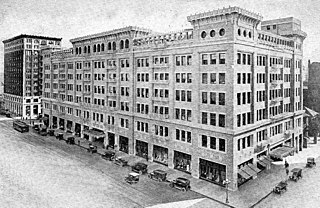
J. W. Robinson Co., Robinson's, was a chain of department stores operating in the Southern California and Arizona area, previously with headquarters in Los Angeles, California.

The Wholesale District is one of seven designated cultural districts in Indianapolis, Indiana, United States. Located in the south-central quadrant of downtown Indianapolis' Mile Square, the district contains the greatest concentration of 19th-century commercial buildings in the city, including Indianapolis Union Station and the Majestic Building. Contemporary landmarks in the district include Circle Centre Mall and the Indianapolis Artsgarden.

Skid Row is the unofficial name for a neighborhood in Downtown Los Angeles officially known as Central City East.
Los Angeles Street, originally known as Calle de los Negros is a major thoroughfare in Downtown Los Angeles, California, dating back to the origins of the city as the Pueblo de Los Ángeles.

The San Fernando Building is an Italian Renaissance Revival style building built in 1906 on Main Street in the Historic Core district of downtown Los Angeles, California. It was listed in the National Register of Historic Places in 1986, converted into lofts in 2000, and declared a Historic-Cultural Monument in 2002.
The Flower District of Downtown Los Angeles is a six block floral marketplace, consisting of nearly 200 wholesale flower dealers, located within the LA Fashion District. What started almost 100 years ago as a small flower mart near Santa Monica, California, has grown into the United States' largest wholesale flower district in its current downtown location. The Market is open very early in the morning, Monday–Saturday, and closes in the early afternoon. Every commercially available cut flower can be purchased there.
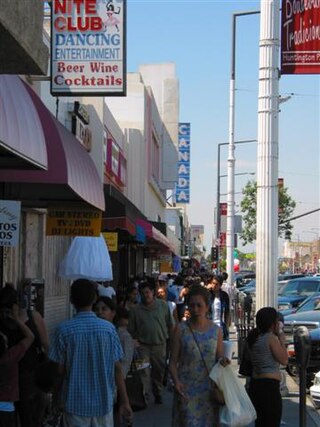
Pacific Boulevard is a street and principal commercial thoroughfare in the city of Huntington Park, California and the Los Angeles County neighborhood of Walnut Park. It runs from Vernon and Santa Fe Avenues in Vernon to Cudahy Street in Walnut Park before changing to Long Beach Boulevard. The Pacific Boulevard commercial district is the third highest grossing commercial district in the County of Los Angeles. The Christmas Lane Parade, seen in millions of homes via television throughout the United States and parts of Europe, has run down Pacific Boulevard since 1946. As many as 300,000 people attend the annual Carnaval Primavera held on Pacific Boulevard each year. Pacific Boulevard is well known to Latino residents of the L.A. area, and a magnet for commerce, culture, and night life.
Izek Shomof is an Israeli-born, American real estate developer, investor, one-time film producer and former restaurateur. Born in Tel Aviv, he dropped out of high school to open restaurants and an autoshop. Since the 1990s, he has restored many historic buildings in Downtown Los Angeles. He has been honored for his philanthropic work in reducing homelessness in Los Angeles.
The Los Angeles Downtown Industrial District (LADID) is manufacturing and wholesale district of downtown Los Angeles, California, that was established as a property-based business improvement district (BID) in 1998 by the Central City East Association (CCEA). The district spans 46 blocks, covers 600 properties, and is the historic home of seafood, produce, flowers, and a variety of products daily shipped in and out of Los Angeles by air, rail, and sea. The LADID hosts the Los Angeles Wholesale Produce Market, the second largest produce market in the United States.

Retail in Southern California dates back to its first dry goods store that Jonathan Temple opened in 1827 on Calle Principal, when Los Angeles was still a Mexican village. After the American conquest, as the pueblo grew into a small town surpassing 4,000 population in 1860, dry goods stores continued to open, including the forerunners of what would be local chains. Larger retailers moved progressively further south to the 1880s-1890s Central Business District, which was later razed to become the Civic Center. Starting in the mid-1890s, major stores moved ever southward, first onto Broadway around 3rd, then starting in 1905 to Broadway between 4th and 9th, then starting in 1915 westward onto West Seventh Street up to Figueroa. For half a century Broadway and Seventh streets together formed one of America's largest and busiest downtown shopping districts.
The retail format influences the consumer's store choice and addresses the consumer's expectations. At its most basic level, a retail format is a simple marketplace, that is; a location where goods and services are exchanged. In some parts of the world, the retail sector is still dominated by small family-run stores, but large retail chains are increasingly dominating the sector, because they can exert considerable buying power and pass on the savings in the form of lower prices. Many of these large retail chains also produce their own private labels which compete alongside manufacturer brands. Considerable consolidation of retail stores has changed the retail landscape, transferring power away from wholesalers and into the hands of the large retail chains.

Row DTLA is a commercial district located in Downtown Los Angeles, which is situated at the intersection of Fashion District, Skid Row, and the Arts District. It spans over 30 acres and was repurposed from the historic Alameda Square complex. The mixed-use development comprises 100 retail stores, restaurants, and 1.3 million square feet of commercial workspace.
















